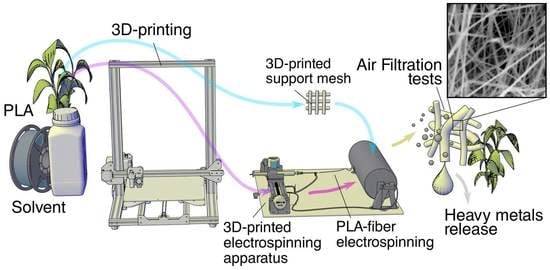Characterization and Filtration Efficiency of Sustainable PLA Fibers Obtained via a Hybrid 3D-Printed/Electrospinning Technique
Abstract
1. Introduction
2. Materials and Methods
2.1. Design and Realization of the Electrospinning Setup
2.2. Fabrication of the PLA-Based Filtration Mask
2.3. Filter Characterization
2.4. Filtration Tests
2.4.1. Laboratory Test
2.4.2. Real-Environment Test
3. Results and Discussion
3.1. Electrospinning Setup and Mask Realization
3.2. Comparison of the PLA-Based 3D-Printed/Electrospun Filtration Efficiency
3.2.1. Laboratory Test Results
3.2.2. Real-Scale Test Results
4. Conclusions
Supplementary Materials
Author Contributions
Funding
Institutional Review Board Statement
Informed Consent Statement
Data Availability Statement
Conflicts of Interest
References
- WHO. Coronavirus Disease (COVID-19): How Is It Transmitted? Available online: https://www.who.int/news-room/q-a-detail/coronavirus-disease-covid-19-how-is-it-transmitted (accessed on 3 March 2021).
- Greenhalgh, T.; Jimenez, J.L.; Prather, K.A.; Tufekci, Z.; Fisman, D.; Schooley, R. Ten scientific reasons in support of airborne transmission of SARS-CoV-2. Lancet 2021, 397, 1603–1605. [Google Scholar] [CrossRef]
- WHO. Infection Prevention and Control of Epidemic-and Pandemic Prone Acute Respiratory Infections in Health Care. Available online: https://www.who.int/publications/i/item/infection-prevention-and-control-of-epidemic-and-pandemic-prone-acute-respiratory-infections-in-health-care (accessed on 4 March 2021).
- Thomas, R.J. Particle size and pathogenicity in the respiratory tract. Virulence 2013, 4, 847–858. [Google Scholar] [CrossRef]
- Rodríguez, S.; Querol, X.; Alastuey, A.; Viana, M.M.; Alarcón, M.; Mantilla, E.; Ruiz, C.R. Comparative PM10-PM2.5 source contribution study at rural, urban and industrial sites during PM episodes in Eastern Spain. Sci. Total Environ. 2004, 328, 95–113. [Google Scholar] [CrossRef]
- World Health Organization. WHO Air Quality Guidelines for Particulate Matter, Ozone, Nitrogen Dioxide and Sulfur Dioxide: Global Update 2005: Summary of Risk Assessment; WHO: Geneva, Switzerland, 2006; pp. 1–22. [Google Scholar] [CrossRef]
- EN 149:2001+A1:2009. Respiratory Protective Devices-Filtering Half Masks to Protect Against Particles-Requirements, Testing, Marking; European Committee for Standardization: Brussels, Belgium, 2001. [Google Scholar]
- National Institute for Occupational Safety and Health (États-Unis). Education and Information Division. NIOSH Guide to the Selection and Use of Particulate Respirators; Certified under 42 CFR 84; National Institute for Occupational Health and Safety, Education and and Information Division: Tokyo, Japan, 1996.
- Prusa Research. 3D Printed Face Shields for Medics and Professionals; Prusa Research: Prague, Czech Republic, 2020. [Google Scholar]
- Isinnova Easy COVID. Available online: https://isinnova.it/archivio-progetti/easy-covid-19/ (accessed on 8 April 2021).
- Potluri, P.; Needham, P. Technical Textiles for Protection; Elsevier: Amsterdam, The Netherlands, 2005. [Google Scholar]
- Aragaw, T.A. Surgical face masks as a potential source for microplastic pollution in the COVID-19 scenario. Mar. Pollut. Bull. 2020, 159, 111517. [Google Scholar] [CrossRef]
- Fadare, O.O.; Okoffo, E.D. COVID-19 face masks: A potential source of microplastic fibers in the environment. Sci. Total Environ. 2020, 737, 140279. [Google Scholar] [CrossRef] [PubMed]
- Kowalczyk, M.; Piorkowska, E.; Kulpinski, P.; Pracella, M. Mechanical and thermal properties of PLA composites with cellulose nanofibers and standard size fibers. Compos. Part A Appl. Sci. Manuf. 2011, 42, 1509–1514. [Google Scholar] [CrossRef]
- Palmieri, S.; Pierpaoli, M.; Riderelli, L.; Qi, S.; Ruello, M.L. Preparation and Characterization of an Electrospun PLA-Cyclodextrins Composite for Simultaneous High-Efficiency PM and VOC Removal. J. Compos. Sci. 2020, 4, 79. [Google Scholar] [CrossRef]
- Pant, B.; Park, M.; Park, S.J. Drug delivery applications of core-sheath nanofibers prepared by coaxial electrospinning: A review. Pharmaceutics 2019, 11, 305. [Google Scholar] [CrossRef]
- Rivera, M.L.; Hudson, S.E. Desktop Electrospinning A Single Extruder 3D Printer for Producing Rigid Plastic and Electrospun Textiles. In Proceedings of the 2019 CHI Conference on Human Factors in Computing Systems, Glasgow, UK, 4–9 May 2019. [Google Scholar]
- Huang, B.; Aslan, E.; Jiang, Z.; Daskalakis, E.; Jiao, M.; Aldalbahi, A.; Vyas, C.; Bártolo, P. Engineered dual-scale poly (ε-caprolactone) scaffolds using 3D printing and rotational electrospinning for bone tissue regeneration. Addit. Manuf. 2020, 36, 101452. [Google Scholar] [CrossRef]
- Kozior, T.; Mamun, A.; Trabelsi, M.; Wortmann, M.; Lilia, S.; Ehrmann, A. Electrospinning on 3D printed polymers for mechanically stabilized filter composites. Polymers 2019, 11, 2034. [Google Scholar] [CrossRef]
- He, H.; Gao, M.; Illés, B.; Molnar, K. 3D Printed and electrospun, transparent, hierarchical polylactic acid mask nanoporous filter. Int. J. Bioprint. 2020, 6, 278. [Google Scholar] [CrossRef] [PubMed]
- Velasco Barraza, R.D.; Álvarez Suarez, A.S.; Villarreal Gómez, L.J.; Paz González, J.A.; Iglesias, A.L.; Vera Graziano, R. Designing a low cost electrospinning device for practical learning in a bioengineering biomaterials course. Rev. Mex. Ing. Bioméd. 2016, 37, 7–16. [Google Scholar]
- GaudiLabs DIY Electrospinner. Available online: http://www.gaudi.ch/GaudiLabs/?page_id=328 (accessed on 5 November 2021).
- Miller, D. OpenESpin. Available online: https://hackaday.io/project/20702-openespin (accessed on 5 November 2021).
- Zhang, J.; Gong, S.; Wang, C.; Jeong, D.Y.; Wang, Z.L.; Ren, K. Biodegradable Electrospun Poly(lactic acid) Nanofibers for Effective PM 2.5 Removal. Macromol. Mater. Eng. 2019, 304, 1900259. [Google Scholar] [CrossRef]
- Selatile, M.K.; Ray, S.S.; Ojijo, V.; Sadiku, R. Depth filtration of airborne agglomerates using electrospun bio-based polylactide membranes. J. Environ. Chem. Eng. 2018, 6, 762–772. [Google Scholar] [CrossRef]
- Patil, N.A.; Gore, P.M.; Prakash, N.J.; Govindaraj, P.; Yadav, R.; Verma, V.; Shanmugarajan, D.; Patil, S.; Kore, A.; Kandasubramanian, B. Needleless electrospun phytochemicals encapsulated nanofibre based 3-ply biodegradable mask for combating COVID-19 pandemic. Chem. Eng. J. 2021, 416, 129152. [Google Scholar] [CrossRef] [PubMed]
- Cao, Q.; Meng, X.; Tan, S.; Xin, Z.; Turng, L.S.; Li, J.; Yao, Z.; Zhai, Z.; Duan, R. Electrospun bead-in-string fibrous membrane prepared from polysilsesquioxane-immobilising poly(lactic acid) with low filtration resistance for air filtration. J. Polym. Res. 2020, 27, 1–3. [Google Scholar] [CrossRef]
- Isarankura Na Ayutthaya, S.; Tanpichai, S.; Sangkhun, W.; Wootthikanokkhan, J. Effect of clay content on morphology and processability of electrospun keratin/poly (lactic acid) nanofiber. Int. J. Biol. Macromol. 2016, 85, 585–595. [Google Scholar] [CrossRef]
- Shen, W.; Ao, F.; Wang, L.; Ge, X.; Ren, H.; Fan, G.; Ning, Y. Effects on ultrafine fibers with electrospun bead jet method based on 3-arm PLA. Mater. Lett. 2020, 261, 127137. [Google Scholar] [CrossRef]
- Li, H.; Wang, Z.; Zhang, H.; Pan, Z. Nanoporous PLA/(Chitosan Nanoparticle) Composite Fibrous Membranes with Excellent Air Filtration and Antibacterial Performance. Polymers 2018, 10, 1085. [Google Scholar] [CrossRef]
- Filip, P.; Zelenkova, J.; Peer, P. Evaluation of an onset of electrospun beadless poly (ethylene oxide) nanofibres. J. Appl. Polym. Sci. 2021, 138, 50001. [Google Scholar] [CrossRef]
- Peer, P.; Filip, P.; Polaskova, M.; Kucharczyk, P.; Pavlinek, V. The influence of sonication of poly (ethylene oxide) solutions to the quality of resulting electrospun nanofibrous mats. Polym. Degrad. Stab. 2016, 126, 101–106. [Google Scholar] [CrossRef]
- Li, P.; Wang, C.; Zhang, Y.; Wei, F. Air filtration in the free molecular flow regime: A review of high-efficiency particulate air filters based on Carbon Nanotubes. Small 2014, 10, 4543–4561. [Google Scholar] [CrossRef] [PubMed]
- Hinds, W.C. Aerosol Technology: Properties, Behavior, and Measurement of Airborne Particles; John Wiley & Sons: Hoboken, NJ, USA, 1999; ISBN 0471194107. [Google Scholar]
- Hasheminassab, S.; Daher, N.; Shafer, M.M.; Schauer, J.J.; Delfino, R.J.; Sioutas, C. Chemical characterization and source apportionment of indoor and outdoor fine particulate matter (PM2.5) in retirement communities of the Los Angeles Basin. Sci. Total Environ. 2014, 490, 528–537. [Google Scholar] [CrossRef] [PubMed]
- Flynn, M.R.; Susi, P. Local exhaust ventilation for the control of welding fumes in the construction industry—A literature review. Ann. Occup. Hyg. 2012, 56, 764–776. [Google Scholar] [CrossRef] [PubMed][Green Version]
- Sánchez-Soberón, F.; Rovira, J.; Sierra, J.; Mari, M.; Domingo, J.L.; Schuhmacher, M. Seasonal characterization and dosimetry-assisted risk assessment of indoor particulate matter (PM10-2.5, PM2.5-0.25, and PM0.25) collected in different schools. Environ. Res. 2019, 175, 287–296. [Google Scholar] [CrossRef]
- Heo, S.; Kim, D.Y.; Kwoun, Y.; Lee, T.J.; Jo, Y.M. Characterization and source identification of fine dust in Seoul elementary school classrooms. J. Hazard. Mater. 2021, 414, 125531. [Google Scholar] [CrossRef]
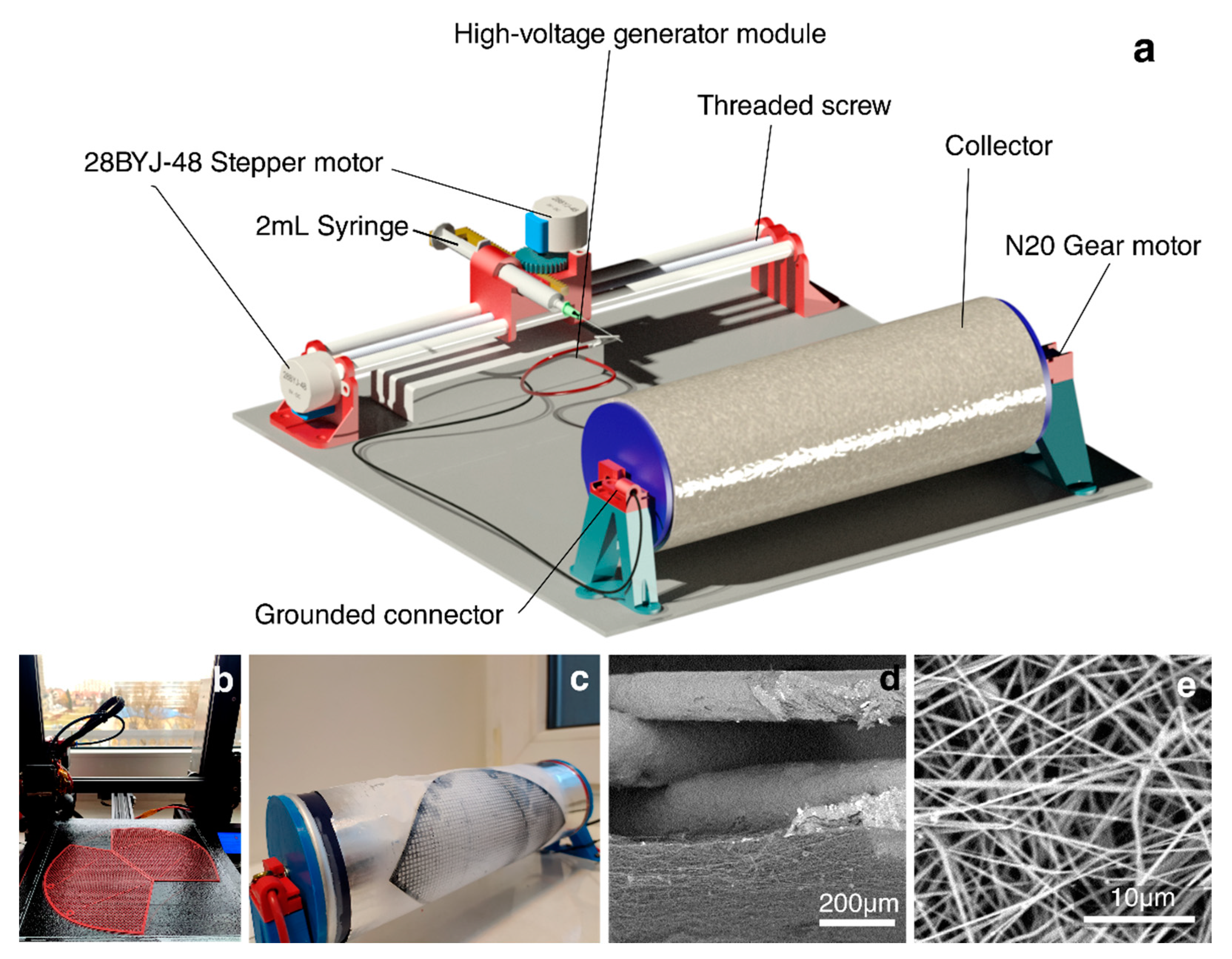
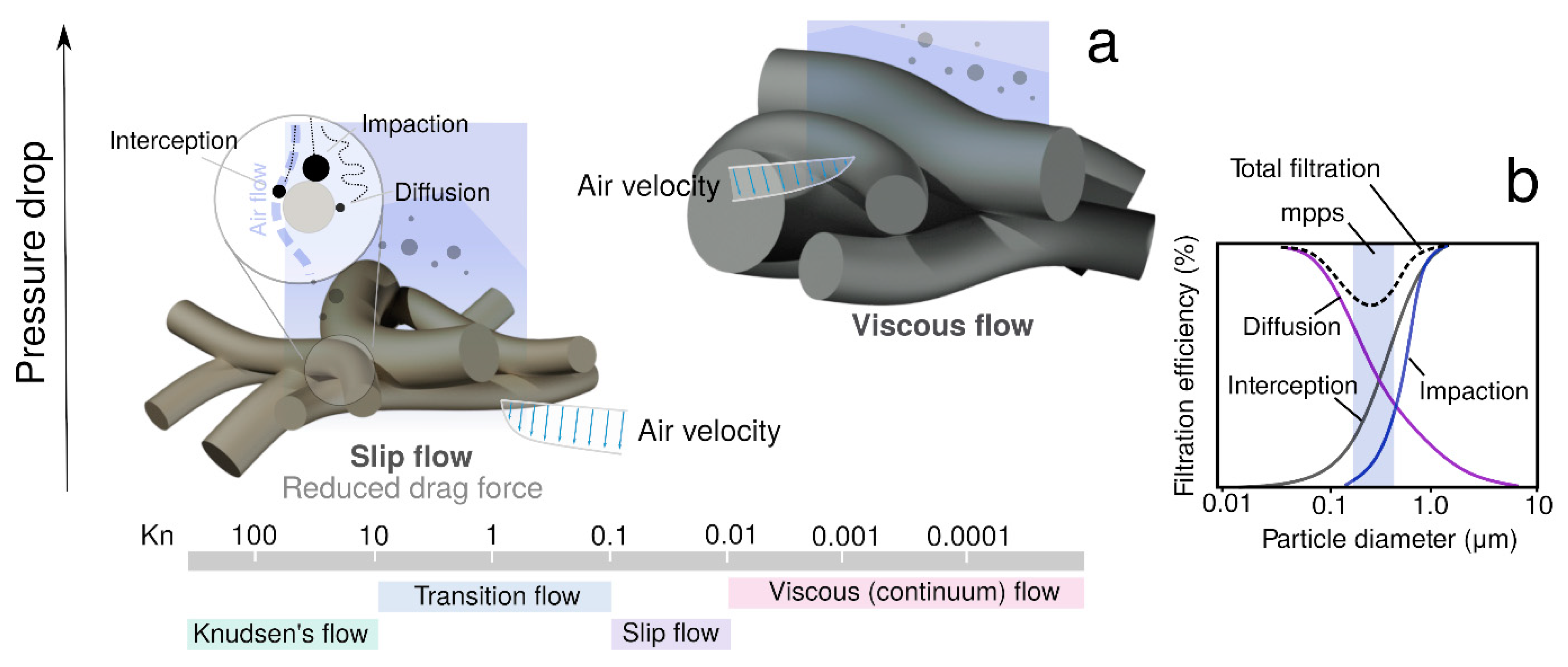
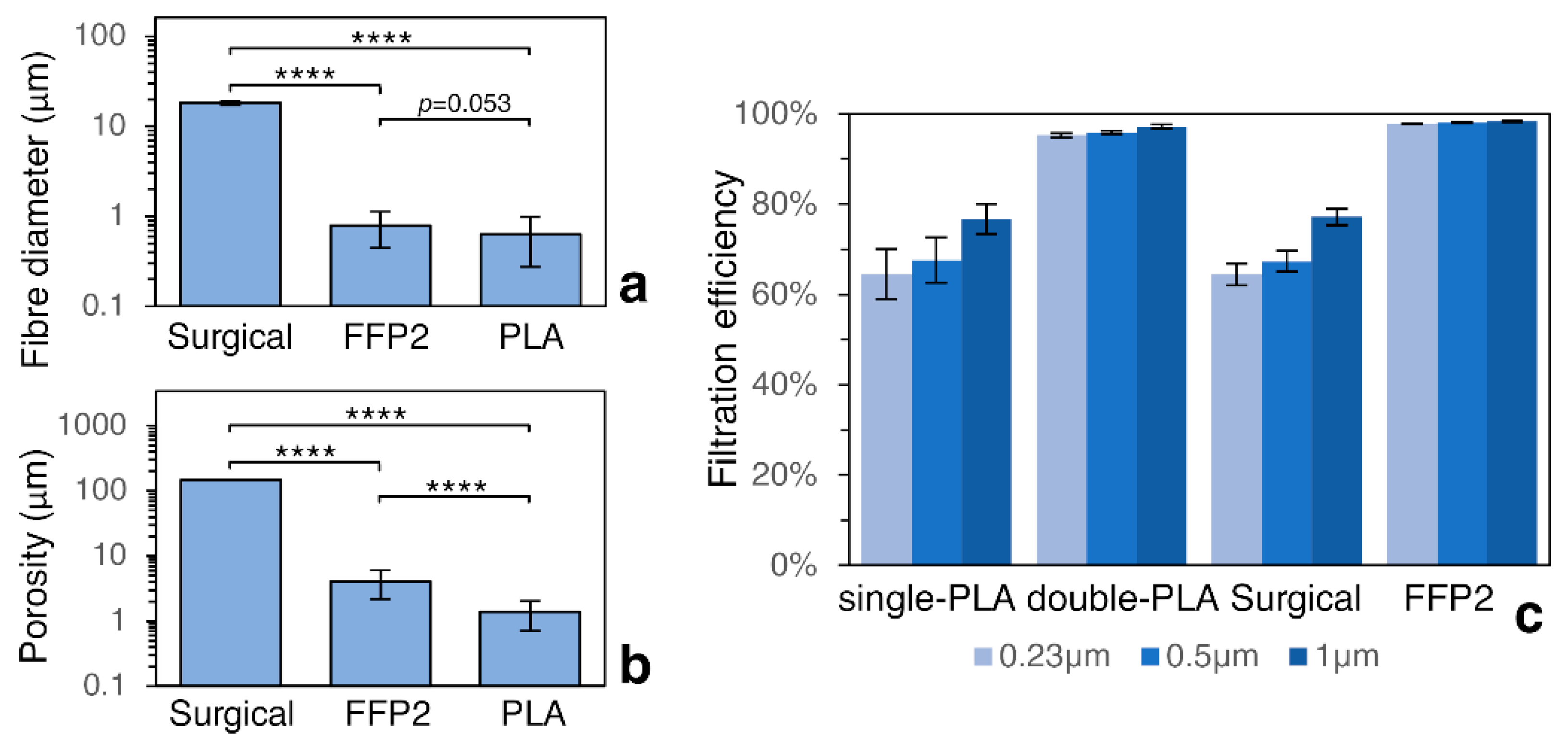
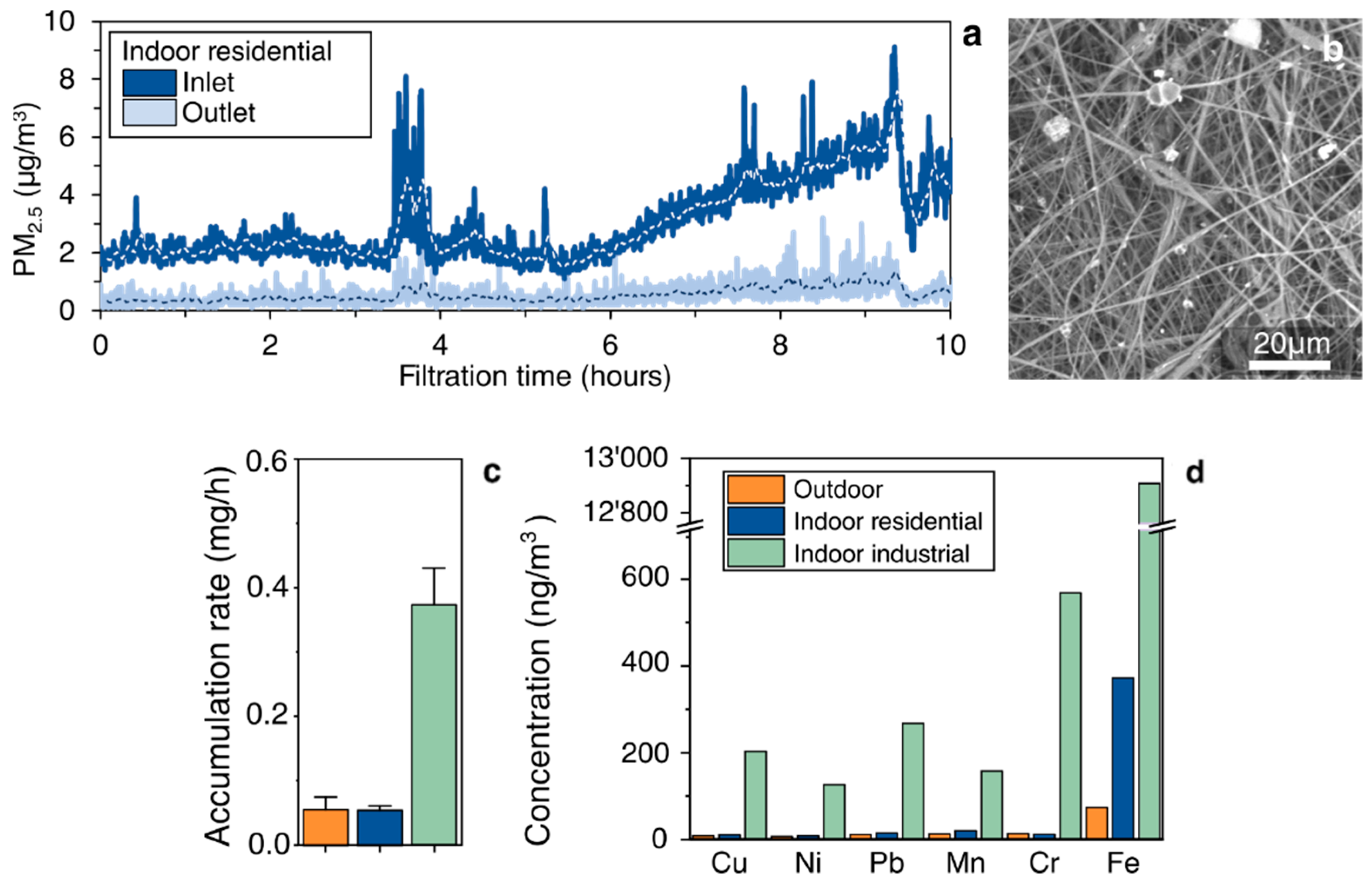
| Fiber Composition | Experimental Parameters (Rate, Solvent, App. Potential, Distance) | Fiber Diameter | Pressure Drop | Filtration Efficiency | Refs. |
|---|---|---|---|---|---|
| PLA/CyD | 0.5 mL/h, 8% w/v DCM/DMF (8:2), 16 kV, 10 cm | 350–990 nm | 24–34 Pa | 97% (PM2.5, incense burning) | [15] |
| PLA | 1 mL/h, 10 wt.%, a DCM/DMF (7:3) solvent +15 (needle) −3 kV (collector) | ~500 nm | 96–102 Pa (8 cm·s−1) | 96.22–99.1% (PM2.5, NaCl) | [24] |
| PLA—PLA/chain extender | DCM/DMF/TFE | From 3 µm to 270 nm | 50–1000 Pa (20–948 L/m−2·s−1) | 92.7–99% Clay (12.07 μm) carbon black (235 nm) TiO2 (95.3 nm) | [25] |
| PLA/cotton fabric layer | DCM Needleless electrospinning collector, −30 kV, rotating electrode 60 kV | 8 ± 0.2 µm | 35.78 Pa/cm2 (8 L/min−1) | 97.9% (S. aureus) | [26] |
| PLA/PSQ | DMF/DCM (3:7 vol) 16 kV, 30 °C, 35~50% (RH), 8–20 cm | Average value from 400 nm to 580 nm | 21.43–37.85 Pa/μm (5.3 cm·s−1) | >99.98% NaCl (0.3 μm) | [27] |
| PLA/montmorillonite/keratin | CHL/AC (70/30 v/v) and formic Acid, 19 kV, 15 cm, and 5 μL/min, | 125–171 nm | 2.88–107.92 Pa (0.12–0.24 m·s−1) | Not evaluated | [28] |
| PLA | CHL/DMSO 15 kV, 1.2 mL/h, 10 cm | 40–100 nm | Not evaluated | Not evaluated | [29] |
| PLA/chitosan | DCM/DMAC 18 kV, collector rotating at 5.5 m/min, 14 cm | 910–1500 nm | 148 Pa (14 cm·s−1) | 98.99% (NaCl) 99.4% (E. coli) 99.5% (S. aureus) | [30] |
Publisher’s Note: MDPI stays neutral with regard to jurisdictional claims in published maps and institutional affiliations. |
© 2021 by the authors. Licensee MDPI, Basel, Switzerland. This article is an open access article distributed under the terms and conditions of the Creative Commons Attribution (CC BY) license (https://creativecommons.org/licenses/by/4.0/).
Share and Cite
Pierpaoli, M.; Giosuè, C.; Czerwińska, N.; Rycewicz, M.; Wieloszyńska, A.; Bogdanowicz, R.; Ruello, M.L. Characterization and Filtration Efficiency of Sustainable PLA Fibers Obtained via a Hybrid 3D-Printed/Electrospinning Technique. Materials 2021, 14, 6766. https://doi.org/10.3390/ma14226766
Pierpaoli M, Giosuè C, Czerwińska N, Rycewicz M, Wieloszyńska A, Bogdanowicz R, Ruello ML. Characterization and Filtration Efficiency of Sustainable PLA Fibers Obtained via a Hybrid 3D-Printed/Electrospinning Technique. Materials. 2021; 14(22):6766. https://doi.org/10.3390/ma14226766
Chicago/Turabian StylePierpaoli, Mattia, Chiara Giosuè, Natalia Czerwińska, Michał Rycewicz, Aleksandra Wieloszyńska, Robert Bogdanowicz, and Maria Letizia Ruello. 2021. "Characterization and Filtration Efficiency of Sustainable PLA Fibers Obtained via a Hybrid 3D-Printed/Electrospinning Technique" Materials 14, no. 22: 6766. https://doi.org/10.3390/ma14226766
APA StylePierpaoli, M., Giosuè, C., Czerwińska, N., Rycewicz, M., Wieloszyńska, A., Bogdanowicz, R., & Ruello, M. L. (2021). Characterization and Filtration Efficiency of Sustainable PLA Fibers Obtained via a Hybrid 3D-Printed/Electrospinning Technique. Materials, 14(22), 6766. https://doi.org/10.3390/ma14226766









